Water Use Strategies and Shoot and Root Traits of High-Yielding Winter Wheat Cultivars under Different Water Supply Conditions
Abstract
:1. Introduction
2. Materials and Methods
2.1. Site Description
2.2. Experimental Design and Field Management
2.3. Measurements
2.3.1. Weather Conditions
2.3.2. Leaf Area Index
2.3.3. Canopy Temperature, Chlorophyll Relative Content and Relative Leaf Water Content
2.3.4. Root Sampling
2.3.5. Soil Water Depletion, Evapotranspiration and Water Productivity
2.3.6. Grain Yield and Above-Ground Biomass
2.4. Statistical Analysis
3. Results
3.1. Weather Conditions during the 2020–2022 Winter Wheat Growing Seasons
3.2. Grain Yield and Water Productivity of Different Cultivars
3.3. Crop Water Use and Soil Water Depletion of Different Cultivars
3.4. Influences of Pre- and Post-Anthesis Water Consumption on Grain Yield and Water Productivity
3.5. Relationships between Root and Shoot Traits and Soil Water Use and Grain Yield
3.5.1. Root Traits
3.5.2. Shoot Traits
4. Discussion
4.1. Choosing Better Cultivars Was Necessary to Increase Grain Yield in the Broad Environment
4.2. Increasing Soil Water Use in Deep Soil Layers after Anthesis Contributed to High Grain Yield under Water Deficit Conditions
4.3. Root and Shoot Traits Contributing to High Grain Yield
4.3.1. Root Traits
4.3.2. Shoot Traits
4.3.3. Using Shoot Traits to Choose More RLD in Deep Soil Layers under Water Deficit Conditions
5. Conclusions
Author Contributions
Funding
Data Availability Statement
Conflicts of Interest
References
- Wulff, B.B.H.; Dhugga, K.S. Wheat—The cereal abandoned by GM Genetic modification of wheat for disease resistance could help stabilize food production. Science 2018, 361, 451–452. [Google Scholar] [CrossRef] [PubMed]
- Kettlewell, P.; Byrne, R.; Jeffery, S. Wheat area expansion into northern higher latitudes and global food security. Agric. Ecosyst. Environ. 2023, 351, 108499. [Google Scholar] [CrossRef]
- Rahimi-Moghaddam, S.; Deihimfard, R.; Azizi, K.; Roostaei, M. Characterizing spatial and temporal trends in drought patterns of rainfed wheat (Triticum aestivum L.) across various climatic conditions: A modelling approach. Eur. J. Agron. 2021, 129, 126333. [Google Scholar] [CrossRef]
- Clarke, D.; Hess, T.M.; Haro-Monteagudo, D.; Semenov, M.A.; Knox, J.W. Assessing future drought risks and wheat yield losses in England. Agric. For. Meteorol. 2021, 297, 108248. [Google Scholar] [CrossRef]
- Saddique, Q.; Liu, D.L.; Wang, B.; Feng, P.Y.; He, J.Q.; Ajaz, A.; Ji, J.M.; Xu, J.T.; Zhang, C.; Cai, H.J. Modelling future climate change impacts on winter wheat yield and water use: A case study in Guanzhong Plain, northwestern China. Eur. J. Agron. 2020, 119, 126113. [Google Scholar] [CrossRef]
- Kunz, K.; Hu, Y.C.; Boincean, B.; Postolatii, A.; Schmidhalter, U. Evaluating the impact of a 2.5–3°C increase in temperature on drought-stressed German wheat cultivars under natural stress conditions. Agric. For. Meteorol. 2023, 332, 109378. [Google Scholar] [CrossRef]
- Mwadzingeni, L.; Shimelis, H.; Dube, E.; Laing, M.D.; Tsilo, T.J. Breeding wheat for drought tolerance: Progress and technologies. J. Integr. Agric. 2016, 15, 935–943. [Google Scholar] [CrossRef]
- Lorite, I.J.; Castilla, A.; Cabezas, J.M.; Alza, J.; Santos, C.; Porras, R.; Gabaldón-Leal, C.; Muñoz-Marchal, E.; Sillero, J.C. Analyzing the impact of extreme heat events and drought on wheat yield and protein concentration, and adaptation strategies using long-term cultivar trials under semi-arid conditions. Agric. For. Meteorol. 2023, 329, 109279. [Google Scholar] [CrossRef]
- Zahra, N.; Wahid, A.; Hafeez, M.B.; Ullah, A.; Siddique, K.H.M.; Farooq, M. Grain development in wheat under combined heat and drought stress: Plant responses and management. Environ. Exp. Bot. 2021, 188, 104517. [Google Scholar] [CrossRef]
- Blum, A. Effective use of water (EUW) and not water-use efficiency (WUE) is the target of crop yield improvement under drought stress. Field Crops Res. 2009, 112, 119–123. [Google Scholar] [CrossRef]
- Thapa, S.; Xue, Q.W.; Jessup, K.E.; Rudd, J.C.; Liu, S.Y.; Pradhan, G.P.; Devkota, R.N.; Baker, J. More Recent Wheat Cultivars Extract More Water from Greater Soil Profile Depths to Increase Yield in the Texas High Plains. Agron. J. 2017, 109, 2771–2780. [Google Scholar] [CrossRef]
- Yang, W.J.; Liu, W.J.; Li, Y.L.; Wang, S.W.; Yin, L.N.; Deng, X.P. Increasing rainfed wheat yield by optimizing agronomic practices to consume more subsoil water in the Loess Plateau. Crop J. 2021, 9, 1418–1427. [Google Scholar] [CrossRef]
- Lu, Y.; Yan, Z.Z.; Li, L.; Gao, C.S.; Shao, L.W. Selecting traits to improve the yield and water use efficiency of winter wheat under limited water supply. Agric. Water Manag. 2020, 242, 106410. [Google Scholar] [CrossRef]
- Figueroa-Bustos, V.; Palta, J.A.; Chen, Y.; Stefanova, K.; Siddique, K.H.M. Wheat cultivars with contrasting root system size responded differently to terminal drought. Front. Plant Sci. 2020, 11, 1285. [Google Scholar] [CrossRef] [PubMed]
- Figueroa-Bustos, V.; Palta, J.A.; Chen, Y.; Siddique, K.H.M. Early season drought largely reduces grain yield in wheat cultivars with smaller root systems. Plants 2019, 8, 305. [Google Scholar] [CrossRef] [PubMed]
- Manschadi, A.M.; Soltani, A. Variation in traits contributing to improved use of nitrogen in wheat: Implications for genotype by environment interaction. Field Crops Res. 2021, 270, 108211. [Google Scholar] [CrossRef]
- Ali, S.; Xu, Y.; Ma, X.; Ahmad, I.; Jia, Q.; Akmal, M.; Hussain, Z.; Arif, M.; Cai, T.; Zhang, J.; et al. Deficit irrigation strategies to improve winter wheat productivity and regulating root growth under different planting patterns. Agric. Water Manag. 2019, 219, 1–11. [Google Scholar] [CrossRef]
- Wu, Y.C.; Zhou, S.L.; Wang, Z.M.; Zhang, X. Residual subsoil nitrogen utilization under water-saving cultivation in winter wheat. Acta Ecol. Sin. 2005, 25, 1869–1873. (In Chinese) [Google Scholar]
- Fang, Q.; Zhang, X.Y.; Chen, S.Y.; Shao, L.W.; Sun, H.Y. Selecting traits to increase winter wheat yield under climate change in the North China Plain. Field Crops Res. 2017, 207, 30–41. [Google Scholar] [CrossRef]
- Li, H.T.; Li, L.; Liu, N.; Chen, S.Y.; Shao, L.W.; Sekiya, N.; Zhang, X.Y. Root efficiency and water use regulation relating to rooting depth of winter wheat. Agric. Water Manag. 2022, 269, 107710. [Google Scholar] [CrossRef]
- Lopes, M.S.; Reynolds, M.P. Partitioning of assimilates to deeper roots is associated with cooler canopies and increased yield under drought in wheat. Funct. Plant Biol. 2010, 37, 147–156. [Google Scholar] [CrossRef]
- Fang, Y.; Liang, L.; Liu, S.; Xu, B.; Siddique, K.H.M.; Palta, J.A.; Chen, Y. Wheat cultivars with small root length density in the topsoil increased post-anthesis water use and grain yield in the semi-arid region on the Loess Plateau. Eur. J. Agron. 2021, 124, 126243. [Google Scholar] [CrossRef]
- Lambers, H.; Atkin, O.K.; Scheureater, I. Respiratory patterns in root in relation to their function. In Plant Roots: The Hidden Half; Waisel, Y., Eshel, A., Kafkafi, U., Eds.; Marcel Dekker: New York, NY, USA, 1996; pp. 323–362. [Google Scholar]
- Vain, S.; Tamm, I.; Tamm, Ü.; Annusver, M.; Zobel, K. Negative relationship between topsoil root production and grain yield in oat and barley. Agric. Ecosyst. Environ. 2023, 349, 108467. [Google Scholar] [CrossRef]
- Wasson, A.; Bischof, L.; Zwart, A.; Watt, M. A portable fluorescence spectroscopy imaging system for automated root phenotyping in soil cores in the field. J. Exp. Bot. 2016, 67, 1033–1043. [Google Scholar] [CrossRef]
- Wasaya, A.; Zhang, X.Y.; Fang, Q.; Yan, Z.Z. Root phenotyping for drought tolerance: A review. Agronomy 2018, 8, 241. [Google Scholar] [CrossRef]
- Becker, S.R.; Byrne, P.F.; Reid, S.D.; Bauerle, W.L.; McKay, J.K.; Haley, S.D. Root traits contributing to drought tolerance of synthetic hexaploid wheat in a greenhouse study. Euphytica 2016, 207, 213–224. [Google Scholar] [CrossRef]
- Rich, S.M.; Jack, C.; Richard, R.; Michelle, W. Root phenotypes of young wheat plants grown in controlled environments show inconsistent correlation with mature root traits in the field. J. Exp. Bot. 2020, 71, 4751–4762. [Google Scholar] [CrossRef]
- Li, H.T.; Shao, L.W.; Liu, X.W.; Sun, H.Y.; Chen, S.Y.; Zhang, X.Y. What matters more, biomass accumulation or allocation, in yield and water productivity improvement for winter wheat during the past two decades? Eur. J. Agron. 2023, 149, 126910. [Google Scholar] [CrossRef]
- Li, X.X.; Ingvordsen, C.H.; Weiss, M.; Rebetake, G.J.; Condon, A.G.; James, R.A.; Richards, R.A. Deeper roots associated with cooler canopies, higher normalized difference vegetation index, and greater yield in three wheat populations grown on stored soil water. J. Exp. Bot. 2019, 70, 4963–4974. [Google Scholar] [CrossRef]
- Wasson, A.P.; Richards, R.A.; Chatrath, R.; Misra, S.C.; Prasad, S.V.; Rebetzke, G.J.; Kirkegaard, J.A.; Christopher, J.; Watt, M. Traits and selection strategies to improve root systems and water uptake in water-limited wheat crops. J. Exp. Bot. 2012, 63, 3485–3498. [Google Scholar] [CrossRef]
- Ti, J.S.; Yang, Y.H.; Pu, L.L.; Wen, X.Y.; Yin, X.G.; Chen, F. Ecological compensation for winter wheat fallow and impact assessment of winter fallow on water sustainability and food security on the North China Plain. J. Clean. Prod. 2021, 328, 129431. [Google Scholar] [CrossRef]
- Yang, X.L.; Wang, G.Y.; Chen, Y.Q.; Sui, P.; Pacenka, S.; Steenhuis, T.S.; Siddique, K.H.M. Reduced groundwater use and increased grain production by optimized irrigation scheduling in winter wheat–summer maize double cropping system—A 16-year field study in North China Plain. Field Crops Res. 2022, 275, 108364. [Google Scholar] [CrossRef]
- Zhang, X.Y.; Qin, W.L.; Xie, J.N. Improving water use efficiency in grain production of winter wheat and summer maize in the North China Plain: A review. Front. Agric. Sci. Eng. 2016, 3, 25–33. [Google Scholar] [CrossRef]
- Fang, Q.; Zhang, X.Y.; Shao, L.W.; Chen, S.Y.; Sun, H.Y. Assessing the performance of different irrigation systems on winter wheat under limited water supply. Agric. Water Manag. 2018, 196, 133–143. [Google Scholar] [CrossRef]
- Jabro, J.D.; Stevens, W.B.; Iversen, W.M. Comparing two methods for measuring soil bulk density and moisture content. Open J. Soil Sci. 2020, 10, 233–243. [Google Scholar] [CrossRef]
- Allen, R.G.; Pereira, L.S.; Raes, D.; Smith, M. Crop Evapotranspiration—Guidelines for 16 Computing Crop Water Requirements; FAO Irrigation and Drainage Paper 56; FAO: Rome, Italy, 1998. [Google Scholar]
- Liu, C.M.; Zhang, X.Y.; Zhang, Y.Q. Determination of daily evaporation and evapotranspiration of winter wheat and maize by large-scale weighing lysimeter and micro-lysimeter. Agric. Forest. Meteorol. 2002, 111, 109–120. [Google Scholar] [CrossRef]
- Zadoks, J.C.; Chang, T.T.; Konzak, C.F. A decimal code for the growth stages of cereals. Weed Res. 1974, 14, 415–421. [Google Scholar] [CrossRef]
- Zegaoui, Z.; Planchais, S.; Cabassa, C.; Djebbar, R.; Belbachir, O.A.; Carol, P. Variation in relative water content, proline accumulation and stress gene expression in two cowpea landraces under drought. J. Plant Physiol. 2017, 218, 26–34. [Google Scholar] [CrossRef] [PubMed]
- Tennant, D. A test of a modified line intersect method of estimating root length. J. Ecol. 1975, 63, 995–1001. [Google Scholar] [CrossRef]
- Liang, S.S.; Li, L.; An, P.; Chen, S.Y.; Shao, L.W.; Zhang, X.Y. Spatial soil water and nutrient distribution affecting the water productivity of winter wheat. Agric. Water Manag. 2021, 256, 107114. [Google Scholar] [CrossRef]
- Zhang, X.Y.; Chen, S.Y.; Sun, H.Y.; Pei, D.; Wang, Y.M. Dry matter, harvest index, grain yield and water use efficiency as affected by water supply in winter wheat. Irrig. Sci. 2008, 27, 1–10. [Google Scholar] [CrossRef]
- Hordofa, A.T.; Leta, O.T.; Alamirew, T.; Chukalla, A.D. Response of winter wheat production to climate change in Ziway Lake Basin. Sustainability 2022, 14, 13666. [Google Scholar] [CrossRef]
- Zhang, X.Y.; Chen, S.Y.; Sun, H.Y.; Wang, Y.M.; Shao, L.W. Root size, distribution and soil water depletion as affected by cultivars and environmental factors. Field Crops Res. 2009, 114, 75–83. [Google Scholar] [CrossRef]
- Couëdel, A.; Edreira, J.I.R.; Lollato, R.; Archontoulis, S.; Sadras, V.; Grassini, P. Assessing environment types for maize, soybean, and wheat in the United States as determined by spatio-temporal variation in drought and heat stress. Agric. For. Meteorol. 2021, 307, 108513. [Google Scholar] [CrossRef]
- Zhao, H.X.; Zhang, P.; Wang, Y.Y.; Ning, T.Y.; Xu, C.L.; Wang, P. Canopy morphological changes and water use effciency in winter wheat under different irrigation treatments. J. Integr. Agric. 2020, 19, 1105–1116. [Google Scholar] [CrossRef]
- Dorrani-Nejad, M.; Kazemipour, A.; Maghsoudi-Moud, A.A.; Abdolshah, R. Wheat breeding for early heading: Does it improve grain yield under drought stress and well-watered conditions? Environ. Exp. Bot. 2022, 200, 104902. [Google Scholar] [CrossRef]
- Thapa, S.; Reddy, S.K.; Fuentealba, M.P.; Xue, Q.; Rudd, J.C.; Jessup, K.E.; Devkota, R.N.; Liu, S. Physiological responses to water stress and yield of winter wheat cultivars differing in drought tolerance. J. Agron. Crop Sci. 2018, 204, 347–358. [Google Scholar] [CrossRef]
- Li, J.P.; Zhang, Z.; Liu, Y.; Yao, C.S.; Song, W.Y.; Xu, X.X.; Zhang, M.; Zhou, X.N.; Gao, Y.M.; Wang, Z.N.; et al. Effects of micro-sprinkling with different irrigation amount on grain yield and water use efficiency of winter wheat in the North China Plain. Agric. Water Manag. 2019, 224, 105736. [Google Scholar] [CrossRef]
- Jha, S.K.; Gao, Y.; Liu, H.; Huang, Z.D.; Wang, G.S.; Liang, Y.P.; Duan, A.W. Root development and water uptake in winter wheat under different irrigation methods and scheduling for North China. Agric. Water Manag. 2017, 182, 139–150. [Google Scholar] [CrossRef]
- Xu, C.L.; Tao, H.B.; Tian, B.J.; Gao, Y.B.; Ren, J.H.; Wang, P. Limited-irrigation improves water use efficiency and soil reservoir capacity through regulating root and canopy growth of winter wheat. Field Crops Res. 2016, 196, 268–275. [Google Scholar] [CrossRef]
- Manschadi, A.M.; Christopher, J.; deVoil, P.; Hammer, G.L. The role of root architectural traits in adaptation of wheat to water-limited environments. Funct. Plant Biol. 2006, 33, 823–837. [Google Scholar] [CrossRef] [PubMed]
- Lilley, J.M.; Kirkegaard, J.A. Benefits of increased soil exploration by wheat roots. Field Crops Res. 2011, 122, 118–130. [Google Scholar] [CrossRef]
- Christopher, J.T.; Manschadi, A.M.; Hammer, G.L.; Borrell, A.K. Developmental and physiological traits associated with high yield and stay-green phenotype in wheat. Aust. J. Agric. Res. 2008, 59, 354–364. [Google Scholar] [CrossRef]
- Dong, Z.Y.; Zhang, X.D.; Li, J.; Zhang, C.; Wei, T.; Yang, Z.; Cai, T.; Zhang, P.; Ding, R.X.; Jia, Z.K. Photosynthetic characteristics and grain yield of winter wheat (Triticum aestivum L.) in response to fertilizer, precipitation, and soil water storage before sowing under the ridge and furrow system: A path analysis. Agric. For. Meteorol. 2019, 272, 12–19. [Google Scholar] [CrossRef]
- Thapa, S.; Xue, Q.W.; Jessup, K.E.; Rudd, J.C.; Liu, S.Y.; Devkota, R.N.; Baker, J.A. Soil water extraction and use by winter wheat cultivars under limited irrigation in a semi-arid environment. J. Arid Environ. 2020, 174, 104046. [Google Scholar] [CrossRef]
- Rezzouk, F.Z.; Gracia-Romero, A.; Kefauver, S.C.; Nieto-Taladriz, M.T.; Serret, M.D.; Araus, J.L. Durum wheat ideotypes in Mediterranean environments differing in water and temperature conditions. Agric. Water Manag. 2022, 259, 107257. [Google Scholar] [CrossRef]
- Masoni, A.; Ercoli, L.; Mariotti, M.; Arduini, I. Post-anthesis accumulation and remobilization of dry matter, nitrogen and phosphorus in durum wheat as affected by soil type. Eur. J. Agron. 2007, 26, 179–186. [Google Scholar] [CrossRef]
- Kirkegaard, J.A.; Lilley, J.M.; Howe, G.N.; Graham, J.M. Impact of subsoil water use on wheat yield. Aust. J. Agric. Res. 2007, 58, 303. [Google Scholar] [CrossRef]
- Moradi, L.; Siosemardeh, A.; Sohrabi, Y.; Bahramnejad, B.; Hosseinpanahi, F. Dry matter remobilization and associated traits, grain yield stability, N utilization, and grain protein concentration in wheat cultivars under supplemental irrigation. Agric. Water Manag. 2022, 263, 107449. [Google Scholar] [CrossRef]
- Passioura, J.B. Grain yield, harvest index, and water use of wheat. J. Aust. Inst. Agric. Sci. 1977, 43, 117–120. [Google Scholar]
- Hu, Y.J.; Ma, P.H.; Wu, S.F.; Sun, B.H.; Feng, H.; Pan, X.L.; Zhang, B.B.; Chen, G.J.; Duan, C.X.; Lei, Q.; et al. Spatial-temporal distribution of winter wheat (Triticum aestivum L.) roots and water use efficiency under ridge–furrow dual mulching. Agric. Water Manag. 2020, 240, 106301. [Google Scholar] [CrossRef]
- Barraclough, P.B.; Weir, A.H. Effects of a compacted subsoil layer on root and shoot growth, water use and nutrient uptake of winter wheat. J. Agric. Sci. 1988, 110, 207–216. [Google Scholar] [CrossRef]
- An, S.Q.; Liu, G.S.; Guo, A.H. Consumption of available soil water stored at planting by winter wheat. Agric. Water Manag. 2003, 63, 99–107. [Google Scholar] [CrossRef]
- Hodgkinson, L.; Dodd, I.C.; Binley, A.; Ashton, R.W.; White, R.P.; Watts, C.W.; Whalley, W.R. Root growth in field-grown winter wheat: Some effects of soil conditions, season and genotype. Eur. J. Agron. 2017, 91, 74–83. [Google Scholar] [CrossRef]
- Ahmed, M.A.; Passioura, J.; Carminati, A. Hydraulic processes in roots and the rhizosphere pertinent to increasing yield of water-limited grain crops: A critical review. J. Exp. Bot. 2018, 69, 3255–3265. [Google Scholar] [CrossRef] [PubMed]
- Lopes, M.S.; Reynolds, M.P. Drought Adaptive Traits and Wide Adaptation in Elite Lines Derived from Resynthesized Hexaploid Wheat. Crop Sci. 2011, 51, 1617–1626. [Google Scholar] [CrossRef]
- Palta, J.A.; Chen, X.; Milroy, S.P.; Rebetzke, G.J.; Dreccer, M.F.; Watt, M. Large root systems: Are they useful in adapting wheat to dry environments? Funct. Plant Biol. 2011, 38, 347–354. [Google Scholar] [CrossRef] [PubMed]
- Ahmadi, S.H.; Sepaskhah, A.R.; Zarei, M. Specific root length, soil water status, and grain yields of irrigated and rainfed winter barley in the raised bed and flat planting systems. Agric. Water Manag. 2018, 210, 304–315. [Google Scholar] [CrossRef]
- Batool, A.; Akram, N.A.; Cheng, Z.G.; Lv, G.C.; Ashraf, M.; Afzal, M.; Xiong, J.L.; Wang, J.Y.; Xiong, Y.C. Physiological and biochemical responses of two spring wheat genotypes to non-hydraulic root-to-shoot signalling of partial and full root-zone drought stress. Plant Physiol. Biochem. 2019, 139, 11–20. [Google Scholar] [CrossRef]
- Ma, S.C.; Xu, B.C.; Li, F.M.; Liu, W.Z.; Huang, Z.B. Effects of root pruning on competitive ability and water use efficiency in winter wheat. Field Crops Res. 2008, 105, 56–63. [Google Scholar] [CrossRef]
- Ehdaie, B.; Layne, A.P.; Waines, J.G. Root system plasticity to drought influences grain yield in bread wheat. Euphytica 2012, 186, 219–232. [Google Scholar] [CrossRef]
- Aziz, M.M.; Palta, J.A.; Siddique, K.H.M.; Sadras, V.O. Five decades of selection for yield reduced root length density and increased nitrogen uptake per unit root length in Australian wheat varieties. Plant Soil. 2017, 413, 181–192. [Google Scholar] [CrossRef]
- Nguyen, T.H.; Langensiepen, M.; Gaiser, T.; Webber, H.; Ahrends, H.; Hueging, H.; Ewert, F. Responses of winter wheat and maize to varying soil moisture: From leaf to canopy. Agric. For. Meteorol. 2022, 314, 108803. [Google Scholar] [CrossRef]
- Rebetzke, G.J.; Jimenez-Berni, J.A.; Bovill, W.D.; Deery, D.M.; James, R.A. High-throughput phenotyping technologies allow accurate selection of stay-green. J. Exp. Bot. 2016, 67, 4919–4924. [Google Scholar] [CrossRef] [PubMed]
- Christopher, M.; Chenu, K.; Jennings, R.; Fletcher, S.; Butler, D.; Borrell, A.; Christopher, J. QTL for stay-green traits in wheat in well-watered and water-limited environments. Field Crops Res. 2018, 217, 32–44. [Google Scholar] [CrossRef]
- Mahmood, Y.A.; DeSilva, J.; King, J.; Foulkes, M.J. Leaf photosynthesis traits and associations with biomass and drought tolerance in amphidiploid and ancestral wheat genotypes. Eur. J. Agron. 2023, 147, 126846. [Google Scholar] [CrossRef]
- Balota, M.; Green, A.J.; Griffey, C.A.; Pitman, R.; Thomason, W. Genetic gains for physiological traits associated with yield in soft red winter wheat in the Eastern United States from 1919 to 2009. Eur. J. Agron. 2017, 84, 76–83. [Google Scholar] [CrossRef]
- Hasanuzzaman, M.; Shabala, L.; Brodribb, T.J.; Zhou, M.; Shabala, S. Assessing the suitability of various screening methods as a proxy for drought tolerance in barley. Funct. Plant Biol. 2017, 44, 253–266. [Google Scholar] [CrossRef] [PubMed]
- Rebetzke, G.J.; Rattey, A.R.; Farquhar, G.D.; Richards, R.A.; Condon, A.T.G. Genomic regions for canopy temperature and their genetic association with stomatal conductance and grain yield in wheat. Funct. Plant Biol. 2013, 40, 14–33. [Google Scholar] [CrossRef]
- Graß, R.; Böttcher, U.; Lilienthal, H.; Wilde, P.; Kage, H. Is canopy temperature suitable for high throughput field phenotyping of drought resistance of winter rye in temperate climate? Eur. J. Agron. 2020, 120, 126104. [Google Scholar] [CrossRef]
- Pinto, R.S.; Reynolds, M.P. Common genetic basis for canopy temperature depression under heat and drought stress associated with optimized root distribution in bread wheat. Theor. Appl. Genet. 2015, 128, 575–585. [Google Scholar] [CrossRef] [PubMed]
- Pinter, P.J.; Zipoli, G.; Reginato, R.J.; Jackson, R.D.; Idso, S.B.; Hohman, J.P. Canopy temperature as an indicator of differential water use and yield performance among wheat cultivars. Agric. Water Manag. 1990, 18, 35–48. [Google Scholar] [CrossRef]
- Watt, M.; Moosavi, S.; Cunningham, S.C.; Kirkegaard, J.A.; Rebetzke, G.J.; Richards, R.A. A rapid, controlled-environment seedling root screen for wheat correlates well with rooting depths at vegetative, but not reproductive, stages at two field sites. Ann. Bot. 2013, 112, 447–455. [Google Scholar] [CrossRef] [PubMed]
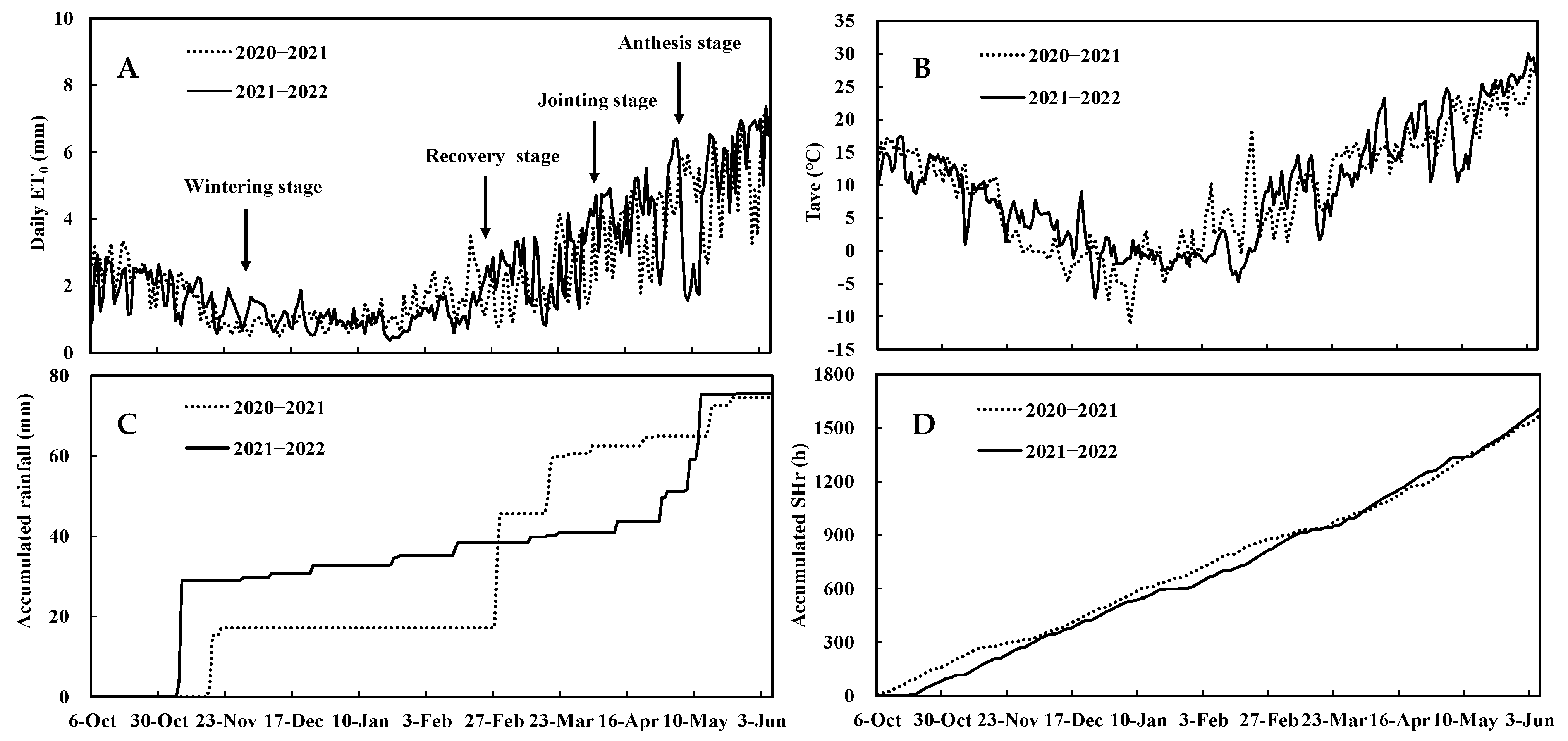



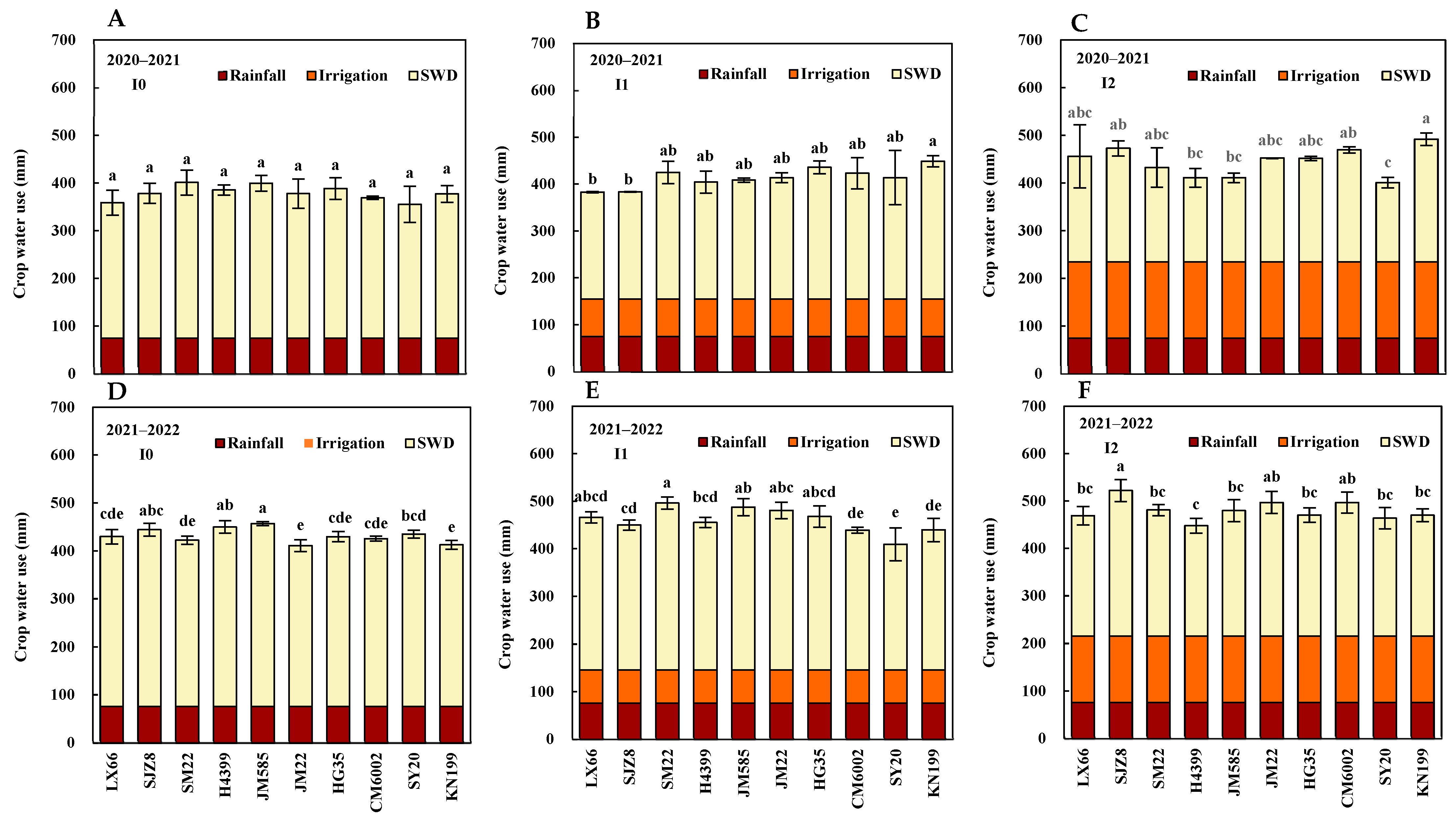



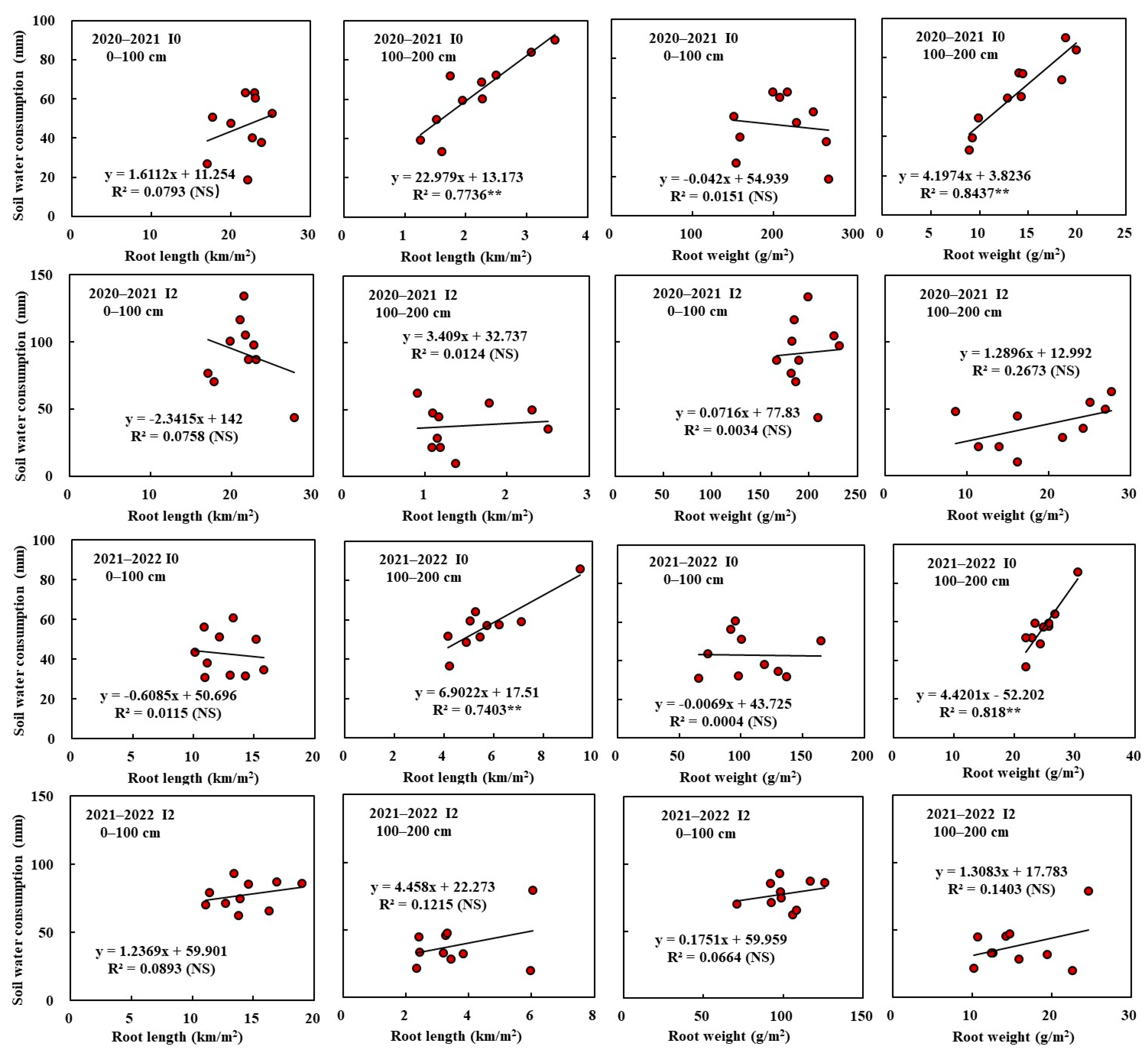

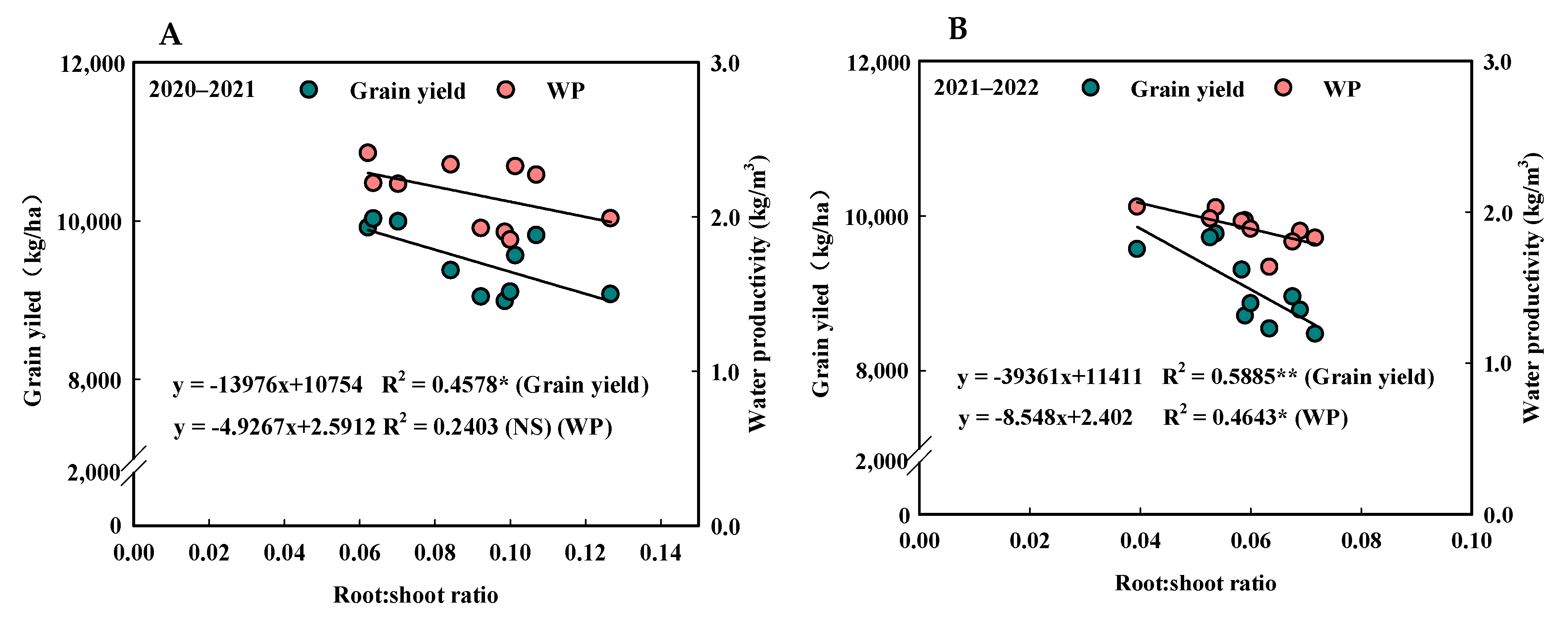

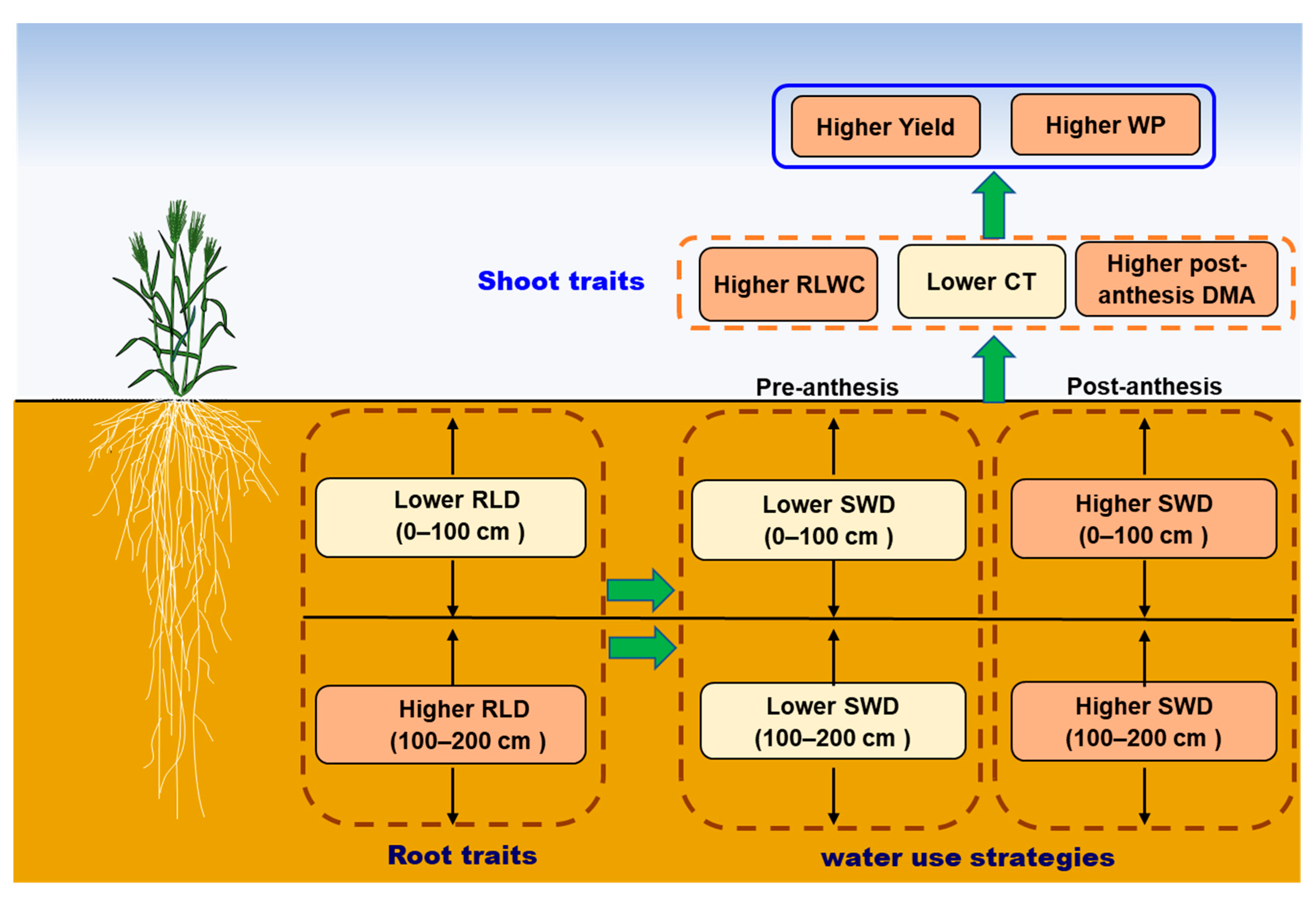
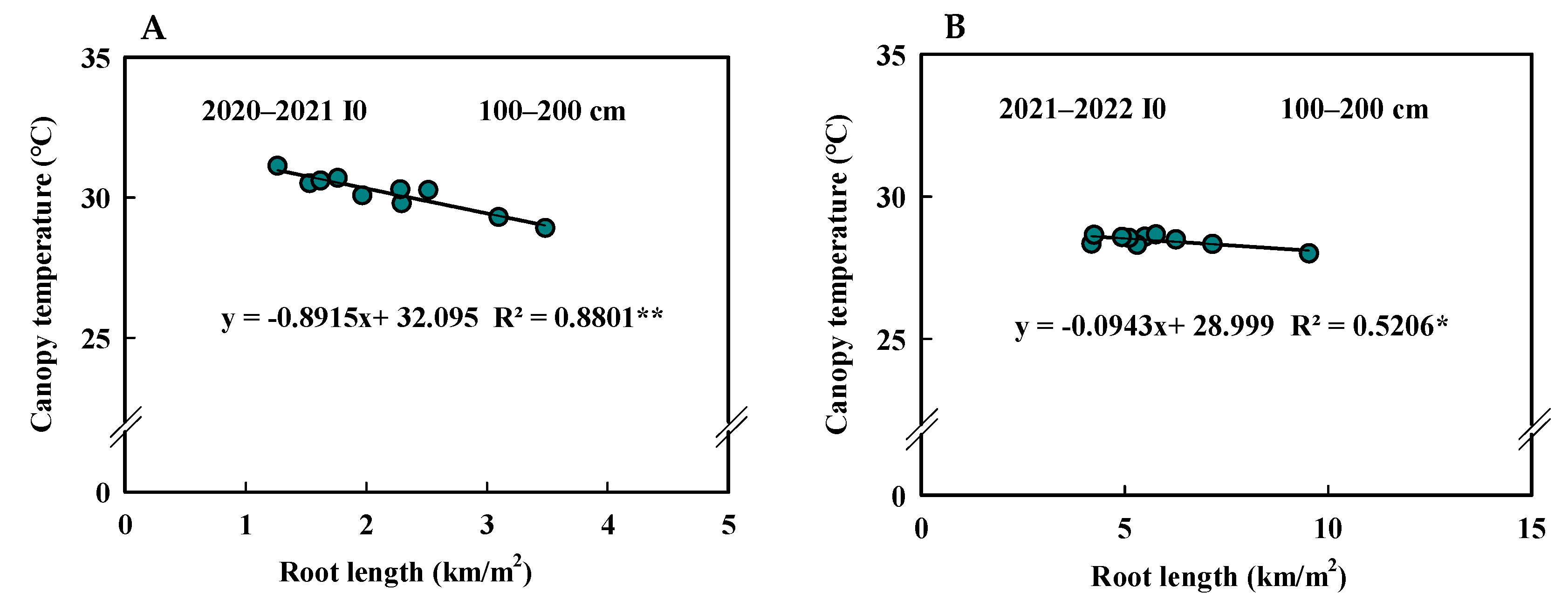
| Sites | Bulk Density (g/cm3) | Field Capacity (g/g) | Saturated Moisture (%) | Organic Matter (g/kg) | Ava. N (mg/kg) | Ava. P (mg/kg) | Ava. K (mg/kg) |
|---|---|---|---|---|---|---|---|
| Site 1 | 1.49 | 0.261 | 43.77 | 17.3 | 80.5 | 18.6 | 197.1 |
| Site 2 | 1.51 | 0.267 | 43.02 | 18.3 | 86.1 | 18.0 | 189.3 |
| Seasons | From Sowing to Anthesis | From Anthesis to Maturity | From Sowing to Maturity | ET-Pre/ET | ET-Post/ET | ||||||||
|---|---|---|---|---|---|---|---|---|---|---|---|---|---|
| SWD1 | SWD2 | SWD3 | SWD1 | SWD2 | SWD3 | SWD1 | SWD2 | SWD3 | |||||
| 2020– 2021 | I0 | Grain yield | − ** | NS | − * | * | ** | ** | NS | * | NS | − ** | ** |
| WP | − ** | − * | − ** | * | * | ** | − * | NS | NS | − ** | ** | ||
| I1 | Grain yield | NS | − * | NS | NS | * | NS | NS | NS | * | NS | NS | |
| WP | NS | NS | NS | NS | NS | NS | NS | NS | NS | NS | NS | ||
| I2 | Grain yield | NS | NS | NS | NS | NS | NS | NS | NS | NS | NS | NS | |
| WP | NS | NS | NS | − * | − ** | − ** | NS | − * | − ** | ** | − ** | ||
| 2021– 2022 | I0 | Grain yield | NS | − ** | − ** | NS | * | * | NS | NS | NS | − * | * |
| WP | NS | − ** | − ** | NS | NS | NS | − * | NS | − * | − * | * | ||
| I1 | Grain yield | NS | NS | NS | NS | * | * | NS | * | * | NS | NS | |
| WP | NS | NS | NS | NS | NS | NS | NS | NS | NS | NS | NS | ||
| I2 | Grain yield | NS | * | NS | NS | NS | NS | NS | NS | NS | NS | NS | |
| WP | NS | NS | NS | − * | NS | − * | NS | NS | NS | NS | NS | ||
Disclaimer/Publisher’s Note: The statements, opinions and data contained in all publications are solely those of the individual author(s) and contributor(s) and not of MDPI and/or the editor(s). MDPI and/or the editor(s) disclaim responsibility for any injury to people or property resulting from any ideas, methods, instructions or products referred to in the content. |
© 2024 by the authors. Licensee MDPI, Basel, Switzerland. This article is an open access article distributed under the terms and conditions of the Creative Commons Attribution (CC BY) license (https://creativecommons.org/licenses/by/4.0/).
Share and Cite
Fang, Q.; Zhang, H.; He, J.; Li, H.; Wang, H.; Li, D.; Lv, X.; Li, R. Water Use Strategies and Shoot and Root Traits of High-Yielding Winter Wheat Cultivars under Different Water Supply Conditions. Agronomy 2024, 14, 826. https://doi.org/10.3390/agronomy14040826
Fang Q, Zhang H, He J, Li H, Wang H, Li D, Lv X, Li R. Water Use Strategies and Shoot and Root Traits of High-Yielding Winter Wheat Cultivars under Different Water Supply Conditions. Agronomy. 2024; 14(4):826. https://doi.org/10.3390/agronomy14040826
Chicago/Turabian StyleFang, Qin, Hongyan Zhang, Jianning He, Haoran Li, Hongguang Wang, Dongxiao Li, Xiaokang Lv, and Ruiqi Li. 2024. "Water Use Strategies and Shoot and Root Traits of High-Yielding Winter Wheat Cultivars under Different Water Supply Conditions" Agronomy 14, no. 4: 826. https://doi.org/10.3390/agronomy14040826





